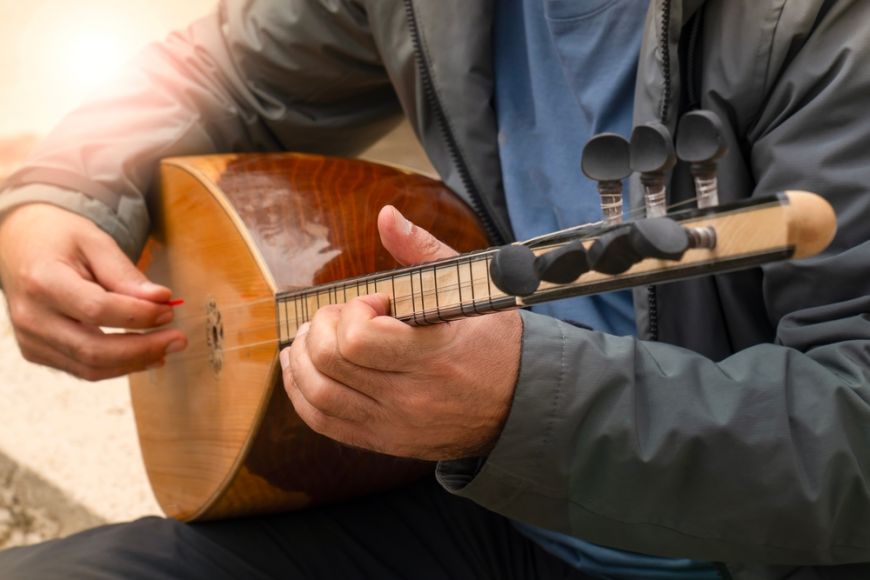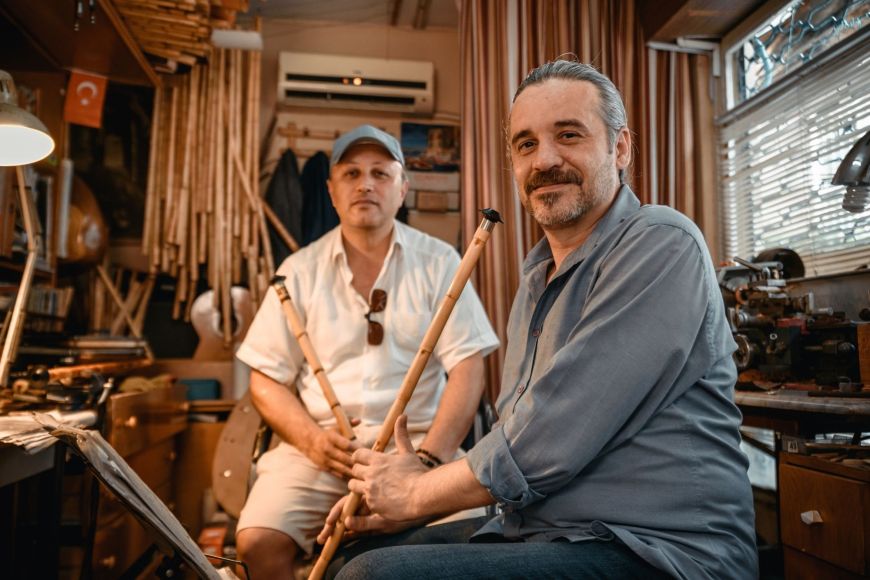Turkey, a country where East meets West, has a rich cultural heritage that includes a diverse and vibrant musical tradition. The unique blend of influences from Asia, Europe, and the Middle East has given rise to a variety of Turkish instruments that have captivated audiences for centuries. This article delves into the world of Turkish instruments, exploring their history, significance, and the beautiful sounds they produce.

The Baglama
History of the Baglama: The baglama, also known as the saz, is one of the most prominent Turkish musical instruments. It has deep roots in Turkish folk music and is often considered the heart and soul of Turkish rural music. The history of the baglama dates back to the 11th century, with its origins believed to be in Central Asia. Over time, it has evolved and become a central instrument in Turkish music.
Structure and Design: The baglama is a long-necked lute with a pear-shaped body and three main parts: the body, neck, and head. It typically has seven strings arranged in three courses. The body is usually made of mulberry or walnut wood, while the neck is often crafted from harder woods like mahogany. The strings were traditionally made of gut but are now commonly made of steel or nylon.
Playing Technique: Playing the baglama requires a plectrum called a tezene. The instrument is known for its rich, resonant sound, which can convey a wide range of emotions. Musicians use various techniques, including plucking, strumming, and fingerpicking, to create intricate melodies and rhythms. The baglama is versatile and can be played solo or as part of an ensemble.
The Turkish Guitar
Evolution of the Turkish Guitar: The Turkish guitar, also known as the "cumbus," is a unique adaptation of the traditional guitar. It was developed in the early 20th century by Zeynel Abidin Cumbus, a Turkish musician and instrument maker. The Turkish guitar combines elements of the Western guitar and traditional Turkish instruments, resulting in a distinctive sound.
Design and Features: The Turkish guitar typically features a round, banjo-like body with a long neck. It has six strings, similar to a standard guitar, but the body is often made of metal or wood covered with a thin membrane. This design gives the Turkish guitar its characteristic bright and metallic sound, making it suitable for a variety of musical genres.
The instrument's versatility and unique sound have made it a favorite among Turkish musicians and a prominent feature in contemporary Turkish music.
Musical Role: The Turkish guitar is used in various musical styles, including folk, classical, and popular music. It is often employed to play intricate melodies and rhythmic accompaniments.
A Diverse Array of Turkish Musical Instruments
In addition to the baglama and Turkish guitar, there are numerous other Turkish musical instruments that contribute to the country's rich auditory tapestry. These instruments can be broadly categorized into string, wind, and percussion instruments.
String Instruments
Oud
The oud is a short-necked lute with a deep, rounded body, and is considered the ancestor of the modern guitar. It is a central instrument in Middle Eastern music and has a prominent place in Turkish classical and folk music. The oud typically has 11 strings arranged in five courses, with an additional single bass string. Its fretless neck allows for a wide range of microtonal intervals, giving it a distinctive and expressive sound.
Kanun
The kanun is a trapezoidal zither with numerous strings that are plucked with plectra attached to the fingers. It is known for its bright, resonant sound and is a key instrument in Turkish classical music. The kanun usually has between 63 and 84 strings, each with a complex tuning mechanism that allows for precise adjustments. This instrument is renowned for its ability to produce rapid arpeggios and glissandos, adding a shimmering texture to the music.

Wind Instruments
Ney
The ney is a reed flute that has been used in Turkish music for over a thousand years. Its haunting, breathy sound is often associated with Sufi music and spiritual ceremonies. The ney is made from a single piece of reed and has six finger holes on the front and one thumb hole on the back. Its sound is produced by blowing across the top of the instrument, creating a rich, airy tone that can be deeply expressive.
Zurna
The zurna is a woodwind instrument with a loud, piercing sound, often used in outdoor celebrations and traditional dances. It is similar to the Western oboe but has a more robust tone. The zurna is typically made from apricot wood and has a conical body with a double-reed mouthpiece. Its powerful sound can carry over long distances, making it ideal for public performances and festive occasions.
Percussion Instruments
Davul
The davul is a large double-headed drum played with mallets. It provides the rhythmic foundation for many types of Turkish music, from folk to military bands. The davul is worn over the shoulder and played with a heavy beater on one side and a lighter stick on the other. This combination allows for a wide range of rhythmic patterns and dynamics, making the davul a versatile and essential instrument in Turkish music.
Darbuka
Also known as the goblet drum, the darbuka is a hand percussion instrument that produces a wide range of tones and rhythms. It is commonly used in Middle Eastern music and dance. The darbuka has a goblet-shaped body made from clay, wood, or metal, and a drumhead made from animal skin or synthetic materials. It is played with the fingers and palms, allowing for intricate and rapid rhythmic patterns that add excitement and energy to the music.
The Cultural Significance of Turkish Musical Instruments
Turkish musical instruments hold profound cultural significance, deeply intertwined with the country's diverse musical traditions. From ancient folk practices to contemporary fusion genres, these instruments play a pivotal role in preserving and evolving Turkey's rich musical heritage. Understanding the role of Turkish musical instruments across various contexts—folk traditions, Sufi music, and modern compositions—reveals their enduring impact on both the cultural and spiritual life of the Turkish people.
Whether through the heartfelt tunes of folk music, the spiritual melodies of Sufi practices, or the innovative blends in modern genres, these instruments continue to enrich Turkey's musical landscape.
Folk Traditions
Turkish musical instruments play a crucial role in the country's rich folk traditions. Instruments like the baglama, kemence, and darbuka are integral to folk dances, storytelling, and celebrations. These instruments help preserve and transmit the cultural heritage of different regions within Turkey. Folk music, often accompanied by these instruments, reflects the everyday life, struggles, and joys of the Turkish people.
Sufi Music
Sufi music, associated with the mystical branch of Islam, uses instruments like the ney and the tambur (a long-necked lute) to create meditative and spiritual atmospheres. The ney, in particular, is considered a symbol of the human soul and its journey towards union with the divine. Sufi ceremonies, such as the whirling dervish rituals, often feature these instruments to induce a state of trance and spiritual reflection.
Modern Turkish Music
In contemporary Turkish music, traditional instruments are often blended with modern genres like pop, rock, and jazz. This fusion creates innovative sounds and helps introduce Turkish musical traditions to a global audience. Artists frequently incorporate instruments like the Turkish guitar and kanun into their compositions, showcasing their versatility. This blending of old and new keeps Turkish music vibrant and relevant in today's global music scene.
By preserving their unique sounds and incorporating them into contemporary compositions, Turkish musicians ensure that their musical heritage remains vibrant and relevant, resonating with audiences both at home and around the world.
Learning to Play Turkish Instruments
Educational Institutions: Several institutions in Turkey offer formal education in traditional Turkish music and instruments. Conservatories and music schools provide courses in playing instruments like the baglama, ney, and oud. These programs help preserve the techniques and repertoire associated with Turkish musical traditions. Students can pursue degrees in Turkish music, ensuring that the knowledge and skills are passed down to future generations.
Workshops and Private Lessons: For those interested in learning Turkish instruments outside formal education, numerous workshops and private lessons are available. Many skilled musicians offer instruction to beginners and advanced students alike. Learning an instrument like the baglama or Turkish guitar can be a deeply rewarding experience, allowing individuals to connect with Turkey's rich musical heritage. Workshops often provide a hands-on approach, immersing participants in the practical and theoretical aspects of Turkish music.
Online Resources: In the digital age, online resources have become invaluable for aspiring musicians. Websites, video tutorials, and online courses offer comprehensive guidance on playing Turkish musical instruments. These resources make it easier for people worldwide to learn and appreciate the beauty of Turkish music. Platforms like YouTube, Udemy, and specialized music websites offer lessons from renowned Turkish musicians, making learning accessible to a global audience.
Preserving Turkish Musical Heritage
Many Turkish musicians and organizations are dedicated to preserving and promoting the country's musical heritage. They organize concerts, festivals, and workshops to showcase traditional instruments and music. Efforts to document and archive music and techniques also play a crucial role in ensuring that future generations can access this rich cultural legacy. Organizations like the Turkish Music Research and Promotion Foundation work tirelessly to keep Turkish music alive and thriving.
The influence of Turkish musical instruments extends beyond Turkey's borders. Musicians worldwide have been inspired by the unique sounds and techniques of instruments like the ney, oud, and baglama. This cross-cultural exchange enriches global music and highlights the universal appeal of Turkish instruments. International collaborations and fusion projects often feature Turkish instruments, introducing their distinctive sounds to diverse audiences.
The world of Turkish instruments is a fascinating blend of history, culture, and music.
From the soulful melodies of the baglama to the bright tones of the Turkish guitar, these instruments offer a window into Turkey's rich musical traditions. Whether used in folk music, Sufi ceremonies, or modern compositions, Turkish musical instruments continue to captivate audiences and preserve the cultural heritage of this vibrant country. Exploring and learning to play these instruments is not only a journey into Turkey's past but also a way to contribute to its living musical legacy.
We are always ready to answer all your questions, please reach out via Whatsapp +90 (532) 158 42 44
If you want to emigrate or buy an apartment in Turkey or own a property in turkey and enjoy life by the sea, message our specialists who will find the best options for your budget.
Also, subscribe to our YouTube channel and Instagram page to receive information from the professionals!
An additional channel to connect with us: Telegram
